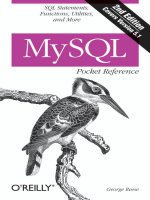Discovering and Exploiting Security Holes Second Edition doc
Bạn đang xem bản rút gọn của tài liệu. Xem và tải ngay bản đầy đủ của tài liệu tại đây (3.51 MB, 744 trang )
Chris Anley
John Heasman
Felix “FX” Linder
Gerardo Richarte
The Shellcoder’s Handbook: Discovering and Exploiting Security Holes
(1st Edition) was written by Jack Koziol, David Litchfield, Dave Aitel,
Chris Anley, Sinan Eren, Neel Mehta, and Riley Hassell.
The Shellcoder’s
Handbook
Discovering and Exploiting Security Holes
Second Edition
Wiley Publishing, Inc.
80238ffirs.qxd:WileyRed 7/11/07 7:22 AM Page iii
Downloa d f r o m W o w ! e B o o k < w w w.woweb o o k . c o m >
80238ffirs.qxd:WileyRed 7/11/07 7:22 AM Page ii
The Shellcoder’s Handbook
Second Edition
80238ffirs.qxd:WileyRed 7/11/07 7:22 AM Page i
80238ffirs.qxd:WileyRed 7/11/07 7:22 AM Page ii
Chris Anley
John Heasman
Felix “FX” Linder
Gerardo Richarte
The Shellcoder’s Handbook: Discovering and Exploiting Security Holes
(1st Edition) was written by Jack Koziol, David Litchfield, Dave Aitel,
Chris Anley, Sinan Eren, Neel Mehta, and Riley Hassell.
The Shellcoder’s
Handbook
Discovering and Exploiting Security Holes
Second Edition
Wiley Publishing, Inc.
80238ffirs.qxd:WileyRed 7/11/07 7:22 AM Page iii
The Shellcoder’s Handbook, Second Edition: Discovering and Exploiting Security Holes
Published by
Wiley Publishing, Inc.
10475 Crosspoint Boulevard
Indianapolis, IN 46256
www.wiley.com
Copyright © 2007 by Chris Anley, John Heasman, Felix “FX” Linder, and Gerardo Richarte
Published by Wiley Publishing, Inc., Indianapolis, Indiana
Published simultaneously in Canada
ISBN: 978-0-470-08023-8
Manufactured in the United States of America
10 9 8 7 6 5 4 3 2 1
No part of this publication may be reproduced, stored in a retrieval system or transmitted in any form
or by any means, electronic, mechanical, photocopying, recording, scanning or otherwise, except as
permitted under Sections 107 or 108 of the 1976 United States Copyright Act, without either the prior
written permission of the Publisher, or authorization through payment of the appropriate per-copy fee
to the Copyright Clearance Center, 222 Rosewood Drive, Danvers, MA 01923, (978) 750-8400, fax (978)
646-8600. Requests to the Publisher for permission should be addressed to the Legal Department, Wiley
Publishing, Inc., 10475 Crosspoint Blvd., Indianapolis, IN 46256, (317) 572-3447, fax (317) 572-4355, or
online at />Limit of Liability/Disclaimer of Warranty: The publisher and the author make no representations or
warranties with respect to the accuracy or completeness of the contents of this work and specifically
disclaim all warranties, including without limitation warranties of fitness for a particular purpose. No
warranty may be created or extended by sales or promotional materials. The advice and strategies con-
tained herein may not be suitable for every situation. This work is sold with the understanding that the
publisher is not engaged in rendering legal, accounting, or other professional services. If professional
assistance is required, the services of a competent professional person should be sought. Neither the
publisher nor the author shall be liable for damages arising herefrom. The fact that an organization or
Website is referred to in this work as a citation and/or a potential source of further information does not
mean that the author or the publisher endorses the information the organization or Website may provide
or recommendations it may make. Further, readers should be aware that Internet Websites listed in this
work may have changed or disappeared between when this work was written and when it is read.
For general information on our other products and services or to obtain technical support, please con-
tact our Customer Care Department within the U.S. at (800) 762-2974, outside the U.S. at (317) 572-3993
or fax (317) 572-4002.
Library of Congress Cataloging-in-Publication Data
The shellcoder’s handbook : discovering and exploiting security holes / Chris Anley [et al.]. —
2nd ed.
p. cm.
ISBN 978-0-470-08023-8 (paper/website)
1. Computer security. 2. Data protection. 3. Risk assessment. I. Anley, Chris.
QA76.9.A25S464 2007
005.8 — dc22
2007021079
Trademarks: Wiley and the Wiley logo are trademarks or registered trademarks of John Wiley & Sons,
Inc. and/or its affiliates, in the United States and other countries, and may not be used without written
permission. All other trademarks are the property of their respective owners. Wiley Publishing, Inc., is
not associated with any product or vendor mentioned in this book.
Wiley also publishes its books in a variety of electronic formats. Some content that appears in print may
not be available in electronic books.
80238ffirs.qxd:WileyRed 7/11/07 7:22 AM Page iv
This book is dedicated to anyone and everyone who understands that
hacking and learning is a way to live your life, not a day job or
semi-ordered list of instructions found in a thick book.
80238ffirs.qxd:WileyRed 7/11/07 7:22 AM Page v
80238ffirs.qxd:WileyRed 7/11/07 7:22 AM Page vi
Chris Anley is a founder and director of NGSSoftware, a security software,
consultancy, and research company based in London, England. He is actively
involved in vulnerability research and has discovered security flaws in a wide
variety of platforms including Microsoft Windows, Oracle, SQL Server, IBM
DB2, Sybase ASE, MySQL, and PGP.
John Heasman is the Director of Research at NGSSoftware. He is a prolific
security researcher and has published many security advisories in enterprise
level software. He has a particular interest in rootkits and has authored papers
on malware persistence via device firmware and the BIOS. He is also a co-author
of The Database Hacker’s Handbook: Defending Database Servers (Wiley 2005).
Felix “FX” Linder leads SABRE Labs GmbH, a Berlin-based professional con-
sulting company specializing in security analysis, system design creation, and
verification work. Felix looks back at 18 years of programming and over a
decade of computer security consulting for enterprise, carrier, and software
vendor clients. This experience allows him to rapidly dive into complex sys-
tems and evaluate them from a security and robustness point of view, even in
atypical scenarios and on arcane platforms. In his spare time, FX works with
his friends from the Phenoelit hacking group on different topics, which have
included Cisco IOS, SAP, HP printers, and RIM BlackBerry in the past.
Gerardo Richarte has been doing reverse engineering and exploit develop-
ment for more than 15 years non-stop. In the past 10 years he helped build the
technical arm of Core Security Technologies, where he works today. His cur-
rent duties include developing exploits for Core IMPACT, researching new
exploitation techniques and other low-level subjects, helping other exploit
writers when things get hairy, and teaching internal and external classes on
assembly and exploit writing. As result of his research and as a humble thank
vii
About the Authors
80238ffirs.qxd:WileyRed 7/11/07 7:22 AM Page vii
you to the community, he has published some technical papers and open
source projects, presented in a few conferences, and released part of his train-
ing material. He really enjoys solving tough problems and reverse engineering
any piece of code that falls in his reach just for the fun of doing it.
viii About the Authors
80238ffirs.qxd:WileyRed 7/11/07 7:22 AM Page viii
Executive Editor
Carol Long
Senior Development Editor
Kevin Kent
Production Editor
Eric Charbonneau
Project Coordinator, Cover
Adrienne Martinez
Copy Editor
Kim Cofer
Editorial Manager
Mary Beth Wakefield
Production Manager
Tim Tate
Vice President and Executive
Group Publisher
Richard Swadley
Vice President and Executive
Publisher
Joseph B. Wikert
Compositor
Craig Johnson,
Happenstance Type-O-Rama
Proofreader
Jen Larsen
Indexer
Johnna VanHoose Dinse
Anniversary Logo Design
Richard Pacifico
Credits
ix
80238ffirs.qxd:WileyRed 7/11/07 7:22 AM Page ix
80238ffirs.qxd:WileyRed 7/11/07 7:22 AM Page x
I would first like to thank all of the people that have made this book possi-
ble — the (many) authors, of course: Gerardo Richarte, Felix “FX” Linder, John
Heasman, Jack Koziol, David Litchfield, Dave Aitel, Sinan Eren, Neel Mehta, and
Riley Hassell. Huge thanks are also due to the team at Wiley — our excellent
Executive Editor Carol Long and our equally excellent Development Editor
Kevin Kent. On a personal note I’d like to thank the team at NGS for a great
many hangovers, technical discussions, hangovers, ideas, and hangovers.
Finally, I’d like to thank my wife Victoria for her enduring patience, love, and
gorgeousness.
— Chris Anley
I would like to thank my friends and family for their unwavering support.
— John Heasman
I would like to thank my friends from Phenoelit, who are still with me despite
the turns and detours life takes and despite the strange ideas I have, technical
and otherwise. Special thanks in this context go to Mumpi, who is a very good
friend and my invaluable support in all kinds of activities. Additional thanks
and kudos go to the SABRE Labs team as well as to Halvar Flake, who is
responsible for the existence of this team in the first place. Last but not least, I
thank Bine for enduring me on a daily basis.
— Felix “FX” Linder
I want to thank those in the community who share what excites them, their
ideas and findings, especially the amazing people at Core, past and present,
and my pals in the exploit writing team with whom the sudden discovery
Acknowledgments
xi
80238ffirs.qxd:WileyRed 7/11/07 7:22 AM Page xi
never ends — it is quite often simple and enlightening. I also want to thank
Chris and John (co-authors) and Kevin Kent from Wiley Publishing, who all
took the time to go through my entangled English, turning it more than just
readable. And I want to thank Chinchin, my love, who’s always by my side,
asking me questions when I need them, listening when I talk or am quiet, and
supporting me, always.
— Gerardo Richarte
xii Acknowledgments
80238ffirs.qxd:WileyRed 7/12/07 6:28 AM Page xii
About the Authors vii
Acknowledgments xi
Introduction to the Second Edition xxiii
Part I Introduction to Exploitation: Linux on x86
Chapter 1 Before You Begin 3
Basic Concepts 3
Memory Management 4
Assembly 6
Recognizing C and C++ Code Constructs in Assembly 7
Conclusion 10
Chapter 2 Stack Overflows 11
Buffers 12
The Stack 13
Functions and the Stack 15
Overflowing Buffers on the Stack 18
Controlling EIP 22
An Interesting Diversion 23
Using an Exploit to Get Root Privileges 25
The Address Problem 27
The NOP Method 33
Defeating a Non-Executable Stack 35
Return to libc 35
Conclusion 39
Contents
xiii
80238ftoc.qxd:WileyRed 7/11/07 7:22 AM Page xiii
Chapter 3 Shellcode 41
Understanding System Calls 42
Writing Shellcode for the exit() Syscall 44
Injectable Shellcode 48
Spawning a Shell 50
Conclusion 59
Chapter 4 Introduction to Format String Bugs 61
Prerequisites 61
What Is a Format String? 61
What Is a Format String Bug? 63
Format String Exploits 68
Crashing Services 69
Information Leakage 70
Controlling Execution for Exploitation 75
Why Did This Happen? 84
Format String Technique Roundup 85
Conclusion 88
Chapter 5 Introduction to Heap Overflows 89
What Is a Heap? 90
How a Heap Works 91
Finding Heap Overflows 91
Basic Heap Overflows 93
Intermediate Heap Overflows 98
Advanced Heap Overflow Exploitation 105
Conclusion 107
Part II Other Platforms—Windows, Solaris, OS/X, and Cisco
Chapter 6 The Wild World of Windows 111
How Does Windows Differ from Linux? 111
Win32 API and PE-COFF 112
Heaps 114
Threading 115
The Genius and Idiocy of the Distributed Common
Object Model and DCE-RPC 116
Recon 118
Exploitation 120
Tokens and Impersonation 120
Exception Handling under Win32 122
Debugging Windows 124
Bugs in Win32 124
Writing Windows Shellcode 125
A Hacker’s Guide to the Win32 API 126
A Windows Family Tree from the Hacker’s Perspective 126
Conclusion 127
xiv Contents
80238ftoc.qxd:WileyRed 7/11/07 7:22 AM Page xiv
Chapter 7 Windows Shellcode 129
Syntax and Filters 129
Setting Up 131
Parsing the PEB 132
Heapoverflow.c Analysis 132
Searching with Windows Exception Handling 148
Popping a Shell 153
Why You Should Never Pop a Shell on Windows 153
Conclusion 154
Chapter 8 Windows Overflows 155
Stack-Based Buffer Overflows 156
Frame-Based Exception Handlers 156
Abusing Frame-Based Exception Handling on
Windows 2003 Server 161
A Final Note about Frame-Based Handler Overwrites 166
Stack Protection and Windows 2003 Server 166
Heap-Based Buffer Overflows 173
The Process Heap 173
Dynamic Heaps 173
Working with the Heap 173
How the Heap Works 174
Exploiting Heap-Based Overflows 178
Overwrite Pointer to RtlEnterCriticalSection in the PEB 178
Overwrite Pointer to Unhandled Exception Filter 185
Repairing the Heap 191
Other Aspects of Heap-Based Overflows 193
Wrapping Up the Heap 194
Other Overflows 194
.data Section Overflows 194
TEB/PEB Overflows 196
Exploiting Buffer Overflows and Non-Executable Stacks 197
Conclusion 203
Chapter 9 Overcoming Filters 205
Writing Exploits for Use with an Alphanumeric Filter 205
Writing Exploits for Use with a Unicode Filter 209
What Is Unicode? 210
Converting from ASCII to Unicode 210
Exploiting Unicode-Based Vulnerabilities 211
The Available Instruction Set in Unicode Exploits 212
The Venetian Method 213
An ASCII Venetian Implementation 214
Decoder and Decoding 218
The Decoder Code 219
Getting a Fix on the Buffer Address 220
Conclusion 221
Contents xv
80238ftoc.qxd:WileyRed 7/11/07 7:22 AM Page xv
Chapter 10 Introduction to Solaris Exploitation 223
Introduction to the SPARC Architecture 224
Registers and Register Windows 224
The Delay Slot 227
Synthetic Instructions 228
Solaris/SPARC Shellcode Basics 228
Self-Location Determination and SPARC Shellcode 228
Simple SPARC exec Shellcode 229
Useful System Calls on Solaris 230
NOP and Padding Instructions 231
Solaris/SPARC Stack Frame Introduction 231
Stack-Based Overflow Methodologies 232
Arbitrary Size Overflow 232
Register Windows and Stack Overflow Complications 233
Other Complicating Factors 233
Possible Solutions 234
Off-By-One Stack Overflow Vulnerabilities 234
Shellcode Locations 235
Stack Overflow Exploitation In Action 236
The Vulnerable Program 236
The Exploit 238
Heap-Based Overflows on Solaris/SPARC 241
Solaris System V Heap Introduction 242
Heap Tree Structure 242
Basic Exploit Methodology (t_delete) 263
Standard Heap Overflow Limitations 266
Targets for Overwrite 267
Other Heap-Related Vulnerabilities 270
Off-by-One Overflows 270
Double Free Vulnerabilities 270
Arbitrary Free Vulnerabilities 271
Heap Overflow Example 271
The Vulnerable Program 272
Other Solaris Exploitation Techniques 276
Static Data Overflows 276
Bypassing the Non-Executable Stack Protection 276
Conclusion 277
Chapter 11 Advanced Solaris Exploitation 279
Single Stepping the Dynamic Linker 281
Various Style Tricks for Solaris SPARC Heap Overflows 296
Advanced Solaris/SPARC Shellcode 299
Conclusion 311
xvi Contents
80238ftoc.qxd:WileyRed 7/11/07 7:22 AM Page xvi
Chapter 12 OS X Shellcode 313
OS X Is Just BSD, Right? 314
Is OS X Open Source? 314
OS X for the Unix-aware 315
Password Cracking 316
OS X PowerPC Shellcode 316
OS X Intel Shellcode 324
Example Shellcode 326
ret2libc 327
ret2str(l)cpy 329
OS X Cross-Platform Shellcode 332
OS X Heap Exploitation 333
Bug Hunting on OS X 335
Some Interesting Bugs 335
Essential Reading for OS X Exploits 337
Conclusion 338
Chapter 13 Cisco IOS Exploitation 339
An Overview of Cisco IOS 339
Hardware Platforms 340
Software Packages 340
IOS System Architecture 343
Vulnerabilities in Cisco IOS 346
Protocol Parsing Code 347
Services on the Router 347
Security Features 348
The Command-Line Interface 348
Reverse Engineering IOS 349
Taking the Images Apart 349
Diffing IOS Images 350
Runtime Analysis 351
Exploiting Cisco IOS 357
Stack Overflows 357
Heap Overflows 359
Shellcodes 364
Conclusion 373
Chapter 14 Protection Mechanisms 375
Protections 375
Non-Executable Stack 376
W^X (Either Writable or Executable) Memory 381
Stack Data Protection 388
AAAS: ASCII Armored Address Space 394
ASLR: Address Space Layout Randomization 396
Heap Protections 399
Windows SEH Protections 407
Other Protections 411
Contents xvii
80238ftoc.qxd:WileyRed 7/11/07 7:22 AM Page xvii
Implementation Differences 413
Windows 413
Linux 417
OpenBSD 421
Mac OS X 422
Solaris 423
Conclusion 425
Part III Vulnerability Discovery
Chapter 15 Establishing a Working Environment 429
What You Need for Reference 430
What You Need for Code 430
gcc 430
gdb 430
NASM 431
WinDbg 431
OllyDbg 431
Visual C++ 431
Python 432
What You Need for Investigation 432
Useful Custom Scripts/Tools 432
All Platforms 434
Unix 434
Windows 435
What You Need to Know 436
Paper Archives 438
Optimizing Shellcode Development 439
Plan the Exploit 439
Write the Shellcode in Inline Assembler 439
Maintain a Shellcode Library 441
Make It Continue Nicely 441
Make the Exploit Stable 442
Make It Steal the Connection 443
Conclusion 443
Chapter 16 Fault Injection 445
Design Overview 447
Input Generation 447
Fault Injection 450
Modification Engines 450
Fault Delivery 455
Nagel Algorithm 455
Timing 455
Heuristics 456
Stateless versus State-Based Protocols 456
Fault Monitoring 456
Using a Debugger 457
FaultMon 457
xviii Contents
80238ftoc.qxd:WileyRed 7/11/07 7:22 AM Page xviii
Putting It Together 458
Conclusion 459
Chapter 17 The Art of Fuzzing 461
General Theory of Fuzzing 461
Static Analysis versus Fuzzing 466
Fuzzing Is Scalable 466
Weaknesses in Fuzzers 468
Modeling Arbitrary Network Protocols 469
Other Fuzzer Possibilities 469
Bit Flipping 469
Modifying Open Source Programs 470
Fuzzing with Dynamic Analysis 470
SPIKE 471
What Is a Spike? 471
Why Use the SPIKE Data Structure to Model Network Protocols? 472
Other Fuzzers 480
Conclusion 480
Chapter 18 Source Code Auditing:
Finding Vulnerabilities in C-Based Languages 481
Tools 482
Cscope 482
Ctags 483
Editors 483
Cbrowser 484
Automated Source Code Analysis Tools 484
Methodology 485
Top-Down (Specific) Approach 485
Bottom-Up Approach 485
Selective Approach 485
Vulnerability Classes 486
Generic Logic Errors 486
(Almost) Extinct Bug Classes 487
Format Strings 487
Generic Incorrect Bounds-Checking 489
Loop Constructs 490
Off-by-One Vulnerabilities 490
Non-Null Termination Issues 492
Skipping Null-Termination Issues 493
Signed Comparison Vulnerabilities 494
Integer-Related Vulnerabilities 495
Different-Sized Integer Conversions 497
Double Free Vulnerabilities 498
Out-of-Scope Memory Usage Vulnerabilities 499
Uninitialized Variable Usage 499
Use After Free Vulnerabilities 500
Multithreaded Issues and Re-Entrant Safe Code 500
Contents xix
80238ftoc.qxd:WileyRed 7/11/07 7:22 AM Page xix
Beyond Recognition: A Real Vulnerability versus a Bug 501
Conclusion 501
Chapter 19 Instrumented Investigation: A Manual Approach 503
Philosophy 503
Oracle extproc Overflow 504
Common Architectural Failures 508
Problems Happen at Boundaries 508
Problems Happen When Data Is Translated 509
Problems Cluster in Areas of Asymmetry 511
Problems Occur When Authentication and
Authorization Are Confused 512
Problems Occur in the Dumbest Places 512
Bypassing Input Validation and Attack Detection 513
Stripping Bad Data 513
Using Alternate Encodings 514
Using File-Handling Features 515
Evading Attack Signatures 517
Defeating Length Limitations 517
Windows 2000 SNMP DOS 520
Finding DOS Attacks 521
SQL-UDP 522
Conclusion 523
Chapter 20 Tracing for Vulnerabilities 525
Overview 526
A Vulnerable Program 527
Component Design 529
Building VulnTrace 538
Using VulnTrace 543
Advanced Techniques 546
Conclusion 548
Chapter 21 Binary Auditing: Hacking Closed Source Software 549
Binary versus Source-Code Auditing: The Obvious Differences 550
IDA Pro—The Tool of the Trade 550
Features: A Quick Crash Course 551
Debugging Symbols 552
Binary Auditing Introduction 552
Stack Frames 552
Calling Conventions 554
Compiler-Generated Code 556
memcpy-Like Code Constructs 560
strlen-Like Code Constructs 560
C++ Code Constructs 561
The this Pointer 561
Reconstructing Class Definitions 562
vtables 562
Quick but Useful Tidbits 563
xx Contents
80238ftoc.qxd:WileyRed 7/11/07 7:22 AM Page xx
Manual Binary Analysis 563
Quick Examination of Library Calls 564
Suspicious Loops and Write Instructions 564
Higher-Level Understanding and Logic Bugs 565
Graphical Analysis of Binaries 566
Manual Decompilation 566
Binary Vulnerability Examples 566
Microsoft SQL Server Bugs 566
LSD’s RPC-DCOM Vulnerability 567
IIS WebDAV Vulnerability 568
Conclusion 570
Part IV Advanced Materials
Chapter 22 Alternative Payload Strategies 573
Modifying the Program 574
The SQL Server 3-Byte Patch 575
The MySQL 1-Bit Patch 578
OpenSSH RSA Authentication Patch 580
Other Runtime Patching Ideas 581
GPG 1.2.2 Randomness Patch 583
Upload and Run (or Proglet Server) 584
Syscall Proxies 584
Problems with Syscall Proxies 587
Conclusion 596
Chapter 23 Writing Exploits that Work in the Wild 597
Factors in Unreliability 597
Magic Numbers 597
Versioning 598
Shellcode Problems 599
Countermeasures 601
Preparation 602
Brute Forcing 602
Local Exploits 603
OS/Application Fingerprinting 603
Information Leaks 605
Conclusion 606
Chapter 24 Attacking Database Software 607
Network Layer Attacks 608
Application Layer Attacks 618
Running Operating System Commands 619
Microsoft SQL Server 619
Oracle 620
IBM DB2 621
Exploiting Overruns at the SQL Level 623
SQL Functions 623
Conclusion 625
Contents xxi
80238ftoc.qxd:WileyRed 7/11/07 7:22 AM Page xxi
Chapter 25 Unix Kernel Overflows 627
Kernel Vulnerability Types 627
0day Kernel Vulnerabilities 636
OpenBSD exec_ibcs2_coff_prep_zmagic() Stack Overflow 636
The Vulnerability 638
Solaris vfs_getvfssw() Loadable Kernel Module
Traversal Vulnerability 642
The sysfs() System Call 644
The mount() System Call 645
Conclusion 646
Chapter 26 Exploiting Unix Kernel Vulnerabilities 647
The exec_ibcs2_coff_prep_zmagic() Vulnerability 647
Calculating Offsets and Breakpoints 652
Overwriting the Return Address and Redirecting Execution 654
Locating the Process Descriptor (or the Proc Structure) 655
Kernel Mode Payload Creation 658
Returning Back from Kernel Payload 659
Getting root (uid=0) 665
Solaris vfs_getvfssw() Loadable Kernel
Module Path Traversal Exploit 672
Crafting the Exploit 673
The Kernel Module to Load 674
Getting root (uid=0) 678
Conclusion 678
Chapter 27 Hacking the Windows Kernel 681
Windows Kernel Mode Flaws—An Increasingly Hunted Species 681
Introduction to the Windows Kernel 682
Common Kernel-Mode Programming Flaws 683
Stack Overflows 684
Heap Overflows 688
Insufficient Validation of User-Mode Addresses 688
Repurposing Attacks 689
Shared Object Attacks 689
Windows System Calls 690
Understanding System Calls 690
Attacking System Calls 692
Communicating with Device Drivers 693
I/O Control Code Components 693
Finding Flaws in IOCTL Handlers 694
Kernel-Mode Payloads 695
Elevating a User-Mode Process 696
Running an Arbitrary User-Mode Payload 699
Subverting Kernel Security 701
Installing a Rootkit 703
Essential Reading for Kernel Shellcoders 703
Conclusion 704
Index 705
xxii Contents
80238ftoc.qxd:WileyRed 7/11/07 7:22 AM Page xxii
Wherever terms have a shifting meaning, independent sets of considerations
are liable to become complicated together, and reasonings and results are fre-
quently falsified.
— Ada Augusta, Countess of Lovelace,
from her notes on “Sketch of The Analytical Engine,” 1842
You have in your hands The Shellcoder’s Handbook Second Edition: Discovering and
Exploiting Security Holes. The first edition of this volume attempted to show the
reader how security vulnerabilities are discovered and exploited, and this
edition holds fast to that same objective. If you’re a skilled network auditor,
software developer, or sysadmin and you want to understand how bugs are
found and how exploits work at the lowest level, you’ve come to the right place.
So what’s this book about? Well, the preceding quotation more or less sums
it up. This book is mostly concerned with arbitrary code execution vulnerabil-
ities, by which we mean bugs, that allow attackers to run code of their choice
on the target machine. This generally happens when a program interprets a
piece of data as a part of the program — part of an http “Host” header
becomes a return address, part of an email address becomes a function pointer,
and so on. The program ends up executing the data the attacker supplied with
disastrous effects. The architecture of modern processors, operating systems,
and compilers lends itself toward this kind of problem — as the good Count-
ess wrote, “the symbols of operation are frequently also the symbols of the
results of operations.” Of course, she was writing about the difficulty of dis-
cussing mathematics when the number “5” might also mean “raised to the
power of 5” or “the fifth element of a series,” but the basic idea is the same. If
you confuse code and data, you’re in a world of trouble. So, this book is about
code and data, and what happens when the two become confused.
Introduction
to the Second Edition
xxiii
80238flast.qxd:WileyRed 7/11/07 7:24 AM Page xxiii









